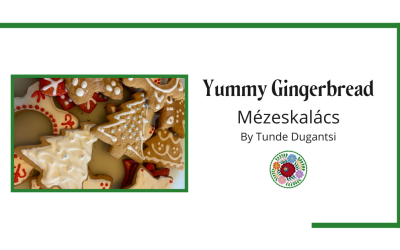I am always fascinated about how families handle Hungarian language challenges. When I heard Lori’s story, I asked if it could be shared and she agreed. Enjoy. ~ Liz
“Nagyon jó! Miért nem találkozunk egy ideig beszélgetni?“
I think that’s what Dorothy was saying to me. Today, I have to think “why don’t we get together some time and talk?” then painstakingly translate it into my very imperfect magyarul. Five years later, I’m still a bit of a beginner with my culture.
Meeting Dorothy kick-started that journey of discovery. We met at the grand opening of a local yoga studio in our neck of the woods in Massachusetts. I had been avoiding the food table all night, hoping to avoid any calorie bombs, but finally went over just to get celery. My eyes wandered, and I saw a little red-white-green stoplight Hungarian flag on one of the dishes. It was palacsinta, and it had a little handwritten description. Someone there was Hungarian.
This always put me on alert. It’s not often you run into Hungarians, and I wanted to run into Hungarians—though by that point, I wasn’t exactly sure why.
My mother is Hungarian. She came to the U.S. by way of Canada in 1961, met my father, married, and settled into becoming the most American of immigrants. Our home was (and is) filled with Uncle Sam, American flags, Coca-Cola signs, Nebraska football, popcorn, and anything else that’s visibly American. My mother never spoke Hungarian to me or my brother. So far as I know, she never spoke it at all, not even to her family, unless forced to do so by an elderly or irritated relative. She embraced her new identity.
All the same, there were some aspects of magyar living that she could never shake. The mainstays of her wonderful cooking and baking were Hungarian, and she magyarized some American classics. I can still see her standing over an enormous pot of boiling water making heaps of nokedli. We opened our presents on Christmas Eve instead of Christmas morning. We had oyster soup on New Year’s Eve. She made poppyseed and cherry kolacsi, cold cherry soup, stuffed cabbage, and strong black coffee.
She also ran her household in strict, old-fashioned magyar ways. We were all turned out in our fanciest clothes for church every week. She had me sleep with rollers in my hair so I could have a fancy hairdo for church, weddings, and other special occasions. I went to school in tights and old-fashioned dresses until sixth grade. Adults were to be treated with respect and given unquestioning obedience. When my brother or I really tried her patience, she would revert to some Hungarian phrases. “Jimmy, don’t be ártatlan!” she would shout when my brother feigned innocence regarding some infraction.
The one thing she did want to instill in us both was that her family was really Hungarian. Our name was Hungarian. “Hungarian people all have names,” she would say, “but our family name is Hungarian.” I had no idea what this meant, but I remembered it, storing it away for the future.
I grew up, I left home, I learned French instead of Hungarian. I eventually wound up in eastern Massachusetts raising my own family, and I found that I really wanted them to know Hungarian. I didn’t want them to be like me and my brother—the only people in the family who didn’t speak Hungarian. (Having the very American name Lori was bad enough; my confused Hungarian relatives called me Larry all through my childhood.) I had learned that you can observe every Hungarian tradition, eat every Hungarian food, but if you can’t speak the language, you are not considered Hungarian. Amazingly, there was a Hungarian school nearby, so I went there to see what we could do.
It wasn’t a success. The moment they realized I didn’t speak the language, their interest evaporated. “We can’t teach your children if they can’t speak the language at home with you every day,” they said, and I was shown the door.
Years went by. I bought DIY Hungarian books and picked up some vocabulary. But I never got very far, and I had reached the point of deciding that the mature thing to do was to let the dream go. I wasn’t Hungarian, I was Hungarian-American, and I could celebrate my culture without speaking the language. My son had learned Spanish, my daughter French. Neither had much interest in our magyar heritage.
Then, for my 50th birthday, my husband said we should all go to Budapest. I was excited but I wanted to be able to speak some Hungarian while we were there.
Shortly afterward, I found myself at the grand opening of my friend’s yoga studio, looking at a tray of palascinta. It seemed like a sign to try again. “Who brought the Hungarian food?” I asked.
“Oh it’s Dorothy, I’ll introduce you,” she said, and in seconds I was telling this stranger that I spoke “egy kicsit” and she was off and running. It was loud in the room, and I barely heard her when she arranged, in English, to meet me at the library on Wednesday night to begin teaching me Hungarian.
I was very nervous about this. Who was this person? Why did I agree to this nonsensical project? She said I could pay her in beigli, so I poured my anxiety into making some, and on Wednesday made my fateful journey to the library.
It turns out Dorothy was in a mirror-image quandary: she came to the U.S. as a child, spoke nothing but Hungarian with her parents and their friends, but as the years went by in America she found fewer and fewer opportunities to speak Hungarian, and found herself searching for vocabulary words. She was considering doing the mature thing and letting go.
Then she met me, and together we went through my DIY Hungarian book, and as she taught me, she recovered the language within herself. We met every week before my trip, and I learned so much—except how to properly pronounce “gy”. It was wonderful to find that we shared so many identical cultural memories and traditions. The “magyar” side of my “magyar-amerikai” identity became stronger. I spoke some Hungarian around the house, though no one understood it.
That quickly changed when my 15 year-old daughter became friends with an Armenian-American girl who was very involved in her culture and language. My language-loving daughter became interested in her own Hungarian identity, and asked me to help her learn the language. I couldn’t do that, but I knew who could…
…and so, with Dorothy’s support and urging, I returned to the Hungarian school, 13 years later, and asked if my daughter could join. The same skeptical eyebrow was raised. Was there someone who she could speak with on a regular basis? And this time, my answer was yes—I had a Hungarian friend who would talk with us both. My daughter joined the group and the cserkész, traveled to Hungary for the Funside Balaton camp, and now speaks more and better Hungarian than I do or likely ever will.
And I finally understand now about Hungarian names. Many immigrants living in Hungary changed their names—“magyarized” them—after the 1848 revolution. They were proud of being second-generation Hungarians, and changed their names to take on that new identity. But my family name is eredeti magyar—Sós.
I considered this. What does it mean to be eredeti maygar? Is it about language? Is it about where you’re born? Is it about what you eat, wear, dance, or sing? Is it a mindset, a desire, a feeling? I suppose it’s all those things, even though many Hungarians would say it’s definitely about where you’re born (in Hungary!) and what you speak (Hungarian!). I’ll always be an American. But to be an American is to be connected by love and memory and family history to another place, or places. No American is an island. To be American is to be plural. That’s why I’m really an eredeti magyar-amerikai, and as I prepare for another season of holiday baking, or I put on my little magyar flag pin, or I sit down at the library with my friend Dori, who is still teaching me Hungarian and friendship five years later, that identity brings me great satisfaction.
Below, Lori’s daughter, Juli, talks about her connection to her Hungarian heritage!
“Ki a családban Magyar, Juli?”
My mother is Hungarian, but my grandmother is the Magyar. That is to say that my grandmother is full-blooded and straight from the homeland. She is where I get my Hungarian blood. But she would never admit this. My grandmother came to America and gave up Hungarian as a language and an identity.
Of course, it wasn’t really gone. My mother always talks about how her childhood was subtly Hungarian, how although the language was never spoken, everything from her family meals to her mother’s parenting tactics were Hungarian. My mother tried one time complaining to her (Hungarian) friend about how her mother made her wear tights everyday to kindergarten, the friend laughed it off “that’s how every Hungarian mother is Lori”.
My mother has the typical first-gen story, with her strangely and sometimes humorously foreign mother, but an American life.
I however, have an even more typical second-gen story. A couple of traditions or meals were leftover from my grandmother, but their names were translated, their origins mostly unimportant. My mother was fél-magyar, but I was just part Hungarian.
This, however, was not going to work for me. As my interest in my heritage strengthened it became more natural to tell people, especially other Hungarians, that draga eédes Anyám magyar. It put me closer to this new-found identity, and in a lot of ways it felt more true. My grandmother had never made dobos torta for me, had never called me Juliska; that was my mother. My mind slowly worked around the blood and the percentages and created a new definition of being Hungarian, one that revolved almost completely around culture.
It was then that I could dive headfirst into the Hungarian world. I began to truly learn the language, I was a debutant at the Bostoni Magyar Iskola’s Cserkesz Bál, I set off on my own for two summers at magyar tabor on Balaton, I made Hungarian friends and even travelled to Budapest with them. Rather quickly, this all began to feel more and more natural. I saw myself and my mother and my childhood in the magyar experience, I felt like I was discovering a new context to my memories, new words to describe them. I felt first-gen. Like my mother.
It was the day I could aid my mother’s Hungarian that something felt different; I felt I had passed some hereditary, familial level. I began to look at my brother, who had never expressed any interest in being Hungarian, and I saw that no matter how I showed him all the Hungarian traces that weaved through our shared home and upbringing he would still be missing a piece of the information. He was missing that connection, that personal resonance I could feel.
It bothered me for a long time that one day, if I have children, they will most likely only be ⅛ Hungarian. I did not know how to pass on something that would feel so far away, yet I desperately wanted to know I could give them this part of me. This led to a simple yet undeniably unexpected realisation: it was a part of me to give. Not part of a grandmother or great-grandmother, but me. A Nagymamám Magyarországból származik, és Édes Anyám nekem adta Magyarországot-
De Én magyar vagyok.
What’s your story?
Want to learn Hungarian, check out our offerings!




